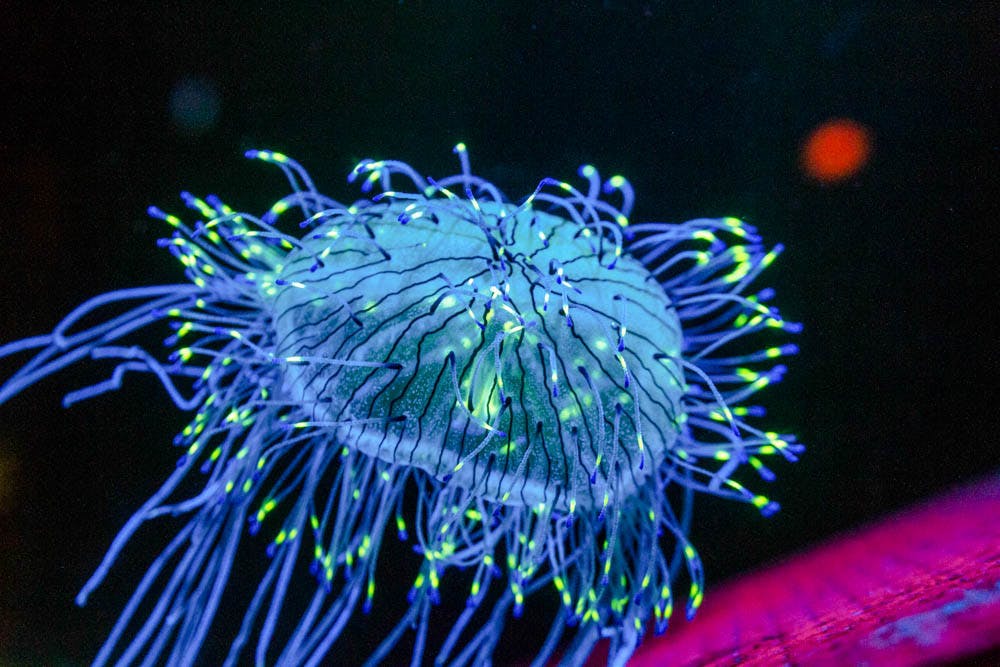A team of University researchers received funding from the National Science Foundation in August 2017 to develop bioluminescent tools that can be used to enhance methods of studying the brain; researchers atCentral Michigan University and the University of California, San Diego also received the funding.
The group studies tools in bioluminescence and optogenetics, the process of altering non-light sensitive cells so that they become light sensitive. They also share the techniques with other scientists and develop ways to engage with students of all levels, said Justine Allen PhD ’14, the group’s program manager. Allen summarized the group’s core goals as “innovation, dissemination and education.”
The group, called The Bioluminescence Hub, is a part of the National Science Foundation’s effort to invest in researchers that innovate new ways to learn about the brain and share those tools with other scientists, according to Christopher Moore, professor of neuroscience and associate director of the Carney Institute for Brain Science. Moore is the principal investigator of the Bioluminescence Hub and leads one of the group’s four labs.
Along with Moore, the other co-principal investigators include Diane Lipscombe, professor of neuroscience and director of the Carney Institute for Brain Science, Ute Hochgeschwender, professor of neuroscience at the College of Medicine at Central Michigan University and Nathan Shaner, principle investigator at the Scintillon Institute. Each researcher leads a lab that focuses on different topics within research on bioluminescence and optogenetics, as they relate to neuroscience. “The four labs in our NeuroNex are working on advancing methods based on bioluminescent tools, and also working hard to openly and very freely disseminate this knowledge at a lot of different levels,” Moore said.
Each lab specializes in a different part of the group’s goals, with Shaner’s lab at the Scintillon Institute working to find, develop and improve fluorescent compounds. “Out of the whole team, we are the most basic science … so one thing we do is we go out into the field, for example to the great barrier reef … and collect samples of fluorescent and luminescent animals,” Shaner said.
Hochgeschwender’s lab takes these compounds and uses molecular biology techniques to tie the bioluminescent molecules to light sensitive proteins and implant the products into the neurons. Her lab, and NeuroNex as a whole, work to encode, in simplistic terms, both a light emitter and light sensor in neurons, opening a whole new variety of applications and tools for scientists, she said.
These modified neurons, with the bioluminescent and optogenetic alternation, are studied in Lipscombe’s lab, where she and other researchers are looking at ways to use light emission as an indication of neuronal activity. “We’re trying to make these molecules bioluminesce when there’s a calcium signal, so we can use these molecules as a proxy for activity,” Lipscombe said.
Moore’s lab takes these same tools to study more complex networks of neurons in the brain. To test theories about how the brain works, researchers often need to record from many neurons — Moore proposed 1,000 neurons as a possible sample size — which can be done in several labs around the world. These labs utilize neurons, modified with these bioluminescent constructs, which flicker each time they fire, allowing researchers to observe activity by counting the series of flashes. “Bioluminescence is a really powerful way of chemically generating light and controlling or watching cells,” he said.
“(This research) allows us to tease out information from the brain in ways not currently possible,” said Hochgeschwender. Shaner also referenced the ways in which bioluminescence can be used to perform live cell microscopy at very high resolution, a challenge researchers face today. On this same point, Lipscombe mentioned how bioluminescence can provide better tools for observing neural activity, something neuroscience researchers continually need. “Being able to see where the brain is active is a huge goal,” Moore said. He added that the combination of bioluminescence and optogenetics could “allow cells to optically communicate where they used to chemically communicate … (and) rewire the brain with light.”
Beyond the research and innovation goals of the group, the Bioluminescence Hub also works to share its technology with other researchers and with students of all education levels, Moore said.
“We’re hoping to educate students and the public at all levels. We have a plan for grade school students, high school students and undergraduates,” Allen said.
“We will use principles of open science to share our tools and knowledge with all interested scientists through our website content, emissary program and workshops. These interactions allow other labs to use our tools to pursue their own research questions and serve as teaching and training opportunities for our graduate students and postdocs,” Allen added in an email to The Herald.
At his lab in California during the summer of 2018, Shaner and his colleagues hosted three undergraduate students and two high school students — one sponsored by NeuroNex — who pursued independent research projects within bioluminescence and molecular biology. The Brown-based labs also offer Undergraduate Research and Teaching Awards for University students, in addition to a program called the Marine Biological Laboratory Undergraduate Practicum. “The (MBL Practicum) is an opportunity for undergraduates, usually juniors and seniors, from all across the United States to come to Woods Hole, MA for a week-long immersive experience (to learn about bioluminescence),” Allen said.
The researchers, with the help of a few high school students this past summer, have also developed a “bioluminescence kit” for high school teachers, which they hope will help teachers present the topic in high school science classes. “We hope to give a zero- or low-cost kit to teachers and a lot of materials to make it easy to teach a hands-on lesson on bioluminescence,” Moore said.
“I think the fun thing about having a collaborative project like this is that … each individual project on its own is great, but they are so much greater when they are combined,” Lipscombe said.





